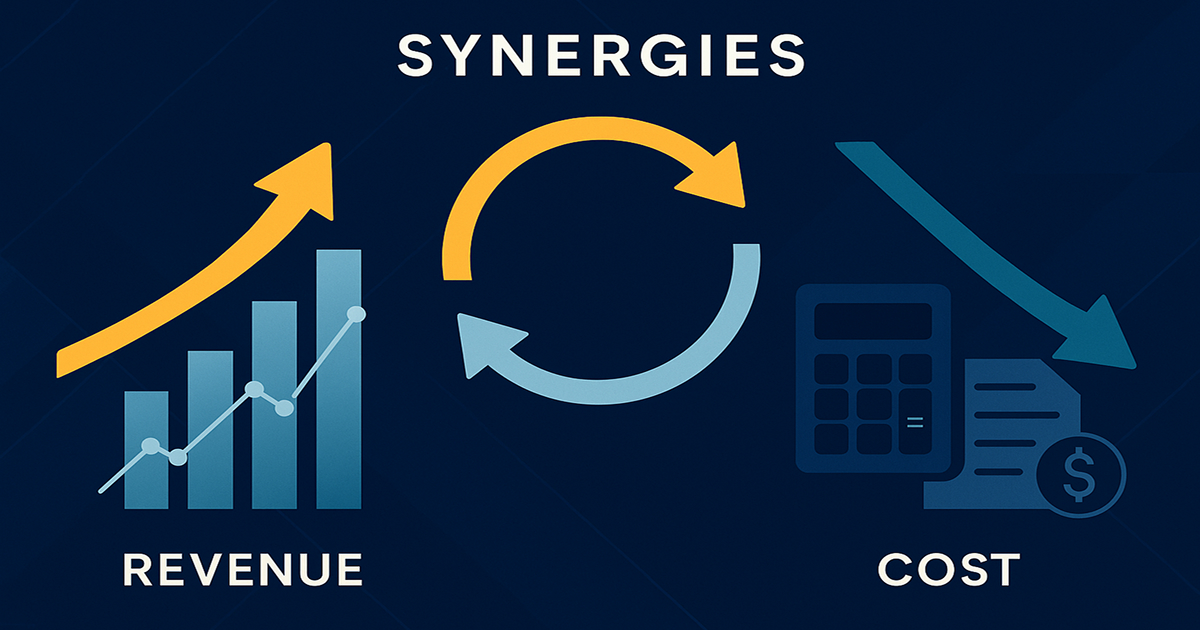Why Synergies Matter in M&A
One of the most common phrases you’ll hear in mergers and acquisitions (M&A) is “realizing synergies.” Buyers often justify paying a premium for a target by projecting cost savings or revenue gains that come from combining two businesses. But not all synergies are created equal. Some are tangible and straightforward to forecast, while others are more speculative.
In interviews—and in real transactions—you'll often be asked about the difference between cost synergies and revenue synergies, why they matter, and how reliable they are. Understanding synergies is crucial since they vary significantly across different types of M&A transactions.
What Are Synergies?
At its core, a synergy is the additional value created when two companies combine compared to what they would generate separately. Analysts, bankers, and corporate executives typically break synergies into two categories:
- Cost synergies: Savings from eliminating redundancies or gaining efficiencies.
- Revenue synergies: Increases in sales or pricing power from the combination.
The distinction is critical because these synergies affect how deals are valued and how realistic management’s projections are.
Cost Synergies
Definition
Cost synergies arise when the combined entity can operate more efficiently than the two companies could on their own. These are typically about eliminating overlaps and streamlining operations.
Common Sources
- Headcount reduction: Removing duplicate corporate functions (finance, HR, legal).
- Facilities consolidation: Shutting down overlapping offices or manufacturing plants.
- Procurement savings: Leveraging larger scale to negotiate better supplier terms.
- IT and systems: Standardizing software, platforms, or infrastructure.
- Distribution/logistics: Optimizing shipping, warehousing, or supply chain routes.
Example
When Kraft and Heinz merged in 2015, one of the key justifications was cost savings. By combining their supply chains and eliminating overlapping roles, the companies estimated billions in cost reductions—many of which materialized within the first few years.
Reliability
Cost synergies are easier to forecast and more likely to be realized. Why?
- They’re often under management’s direct control (e.g., cutting duplicate staff).
- They can be quantified with relatively high confidence (e.g., office lease savings).
- They tend to materialize within 12–24 months after a deal closes.
That’s why analysts usually give more weight to cost synergies in financial models.
Revenue Synergies
Definition
Revenue synergies occur when the combined company can generate more sales than the two firms could have separately.
Common Sources
- Cross-selling: Selling one company’s products to the other’s customers.
- Geographic expansion: Leveraging a partner’s presence in a new market.
- Product bundling: Offering complementary products as a package.
- Stronger pricing power: Using increased scale to raise prices.
- New growth opportunities: Entering entirely new markets or industries.
Example
When Microsoft acquired LinkedIn in 2016, part of the thesis was revenue synergies. Microsoft could integrate LinkedIn data into Office products, creating upselling opportunities and better targeting for advertisers. While promising, these gains were harder to measure at the time of the deal.
Reliability
Revenue synergies are harder to forecast and less certain because:
- They depend on customer behavior (e.g., will clients actually buy more?).
- They require successful integration of sales teams, products, or technology.
- They often take years to fully materialize, if at all.
Analysts typically discount revenue synergies heavily in valuations.
Why Cost Synergies Drive Deal Justifications
When bankers prepare M&A models or pitch books, they often highlight both types of synergies. However, cost synergies carry more weight for several reasons:
1. Control – Management can decide to cut costs immediately, while revenue growth depends on external factors.
2. Faster realization – Cost cuts start showing up in financials within months, while revenue benefits may take years.
3. Investor confidence – Shareholders and analysts are skeptical of lofty revenue projections but are more willing to accept cost savings.
4. Impact on valuation – Because they’re more certain, cost synergies justify higher premiums paid in a deal.
How Synergies Affect Valuation
In discounted cash flow (DCF) and merger models, synergies are factored into projected financials:
- Cost synergies: Increase operating margins, reduce SG&A, and boost free cash flow.
- Revenue synergies: Increase revenue growth rates and market share assumptions.
However, most conservative analysts and interviewers will stress: always haircut revenue synergies. For example, if management claims 200 million. When synergies don't materialize as expected, it can lead to goodwill impairment and complex M&A accounting adjustments.
Additional Real-World Examples
- Amazon and Whole Foods (2017): Cost synergies from supply chain efficiencies and reduced distribution costs. Revenue synergies through Prime membership integration and cross-selling groceries online.
- Disney and 21st Century Fox (2019): Cost savings from consolidating studio operations. Revenue opportunities through bundled streaming services (Disney+, Hulu, ESPN+).
- ExxonMobil and XTO Energy (2010): Expected synergies from operational efficiencies in natural gas. Revenue synergies were harder to prove given commodity price volatility.
Key Takeaways
- Cost synergies are about efficiency—cutting expenses, eliminating duplication, and streamlining operations. They are easier to quantify, faster to realize, and more likely to materialize.
- Revenue synergies are about growth—cross-selling, pricing power, or market expansion. They are harder to measure, slower to develop, and less certain.
- In valuations, cost synergies are weighted heavily, while revenue synergies are often discounted.
- Always be prepared in interviews to give examples of both and to explain why cost synergies are the “safer” bet.
- Practice explaining these concepts: Use our iOS app to test your understanding with M&A questions and get comfortable explaining synergies out loud before your interview.
Conclusion
Synergies can make or break an M&A deal. Understanding the difference between cost and revenue synergies is essential for bankers, investors, and interview candidates alike.
When you're in an interview, being able to articulate these concepts clearly and provide real-world examples will set you apart. Master all M&A concepts and interview questions with our comprehensive guide—covering technical topics, behavioral questions, and everything you need to succeed.
